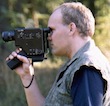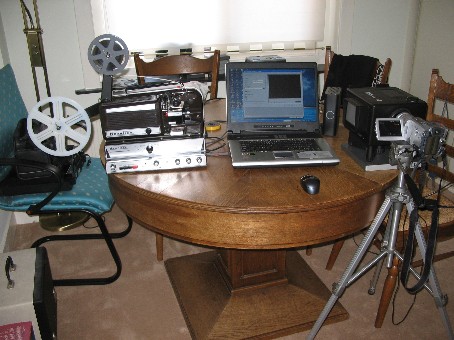|
Author
|
Topic: From 8 mm to DVD
|
|
|
|
|
|
|
|
|
|
|
|
|
Joerg Polzfusz
Jedi Master Film Handler

Posts: 815
From: Berlin, Germany, Europe, Earth, Solar System
Registered: Apr 2006
|
 posted July 31, 2007 06:25 AM
posted July 31, 2007 06:25 AM





quote:
You need to have your hard drive reformatted to NTFS this will stop your camcorder stopping after five minutes.
Sorry, but this is nonsense! The PC's harddrive has got nothing do with the camera's "auto power off"-feature! You'll either have to turn off the camera's "auto power off" in the camera's settings - or by inserting a tape. When the tape doesn't do the trick, you'll have to set the camera to "record".
When it's your PC that stops: Upgrade your Software. Older software might not be able to handle files larger than 1GB, 2 GB or 4GB. (5min in DV-codec = approx. 1 GB)
When your harddisk is formatted in FAT16 the max. file-size is 2GB independent of your software. When using FAT32 (default for Win95, 98, ME) the max. file-size is 4GB. The 4GB-limit also affects older versions of the MacOS. NTFS (default for WinNT, Win2000, WinXP, WinVista) or the file-systems used by Linux or newer versions of MacOS don't have such a max. file-size.
Jörg
| IP: Logged
|
|
|
|
|
|
|
|
|
|
|
|
|
|
|
|
|
|
|
|
Brad Miller
Administrator

Posts: 525
From: Dallas, TX, USA
Registered: Jun 2003
|
 posted August 11, 2007 02:07 AM
posted August 11, 2007 02:07 AM




Setup the projector next to the videocamera so they are as close together as possible (the videocamera being on the non-operator side of the projector). I usually set the videocamera just above and to the left so that the reels *almost* get in the picture.
Zoom the image as small as you can and shoot from a good distance. This will help you buy some depth of focus in your lens as well as virtually eliminate keystoning.
Shoot onto a piece of white formica. Seriously, this works amazing.
Use a 24P DV videocamera, such as the Panasonic DVX-100. These can be had quite cheap these days and work magnificently (it's what I use).
Record in 24PA (advance pull down mode) so you can author your DVDs at a true 24FPS later without the extra duplicated frames.
Set the videocamera's shutter speed as high as you can. You will notice strobing on the viewfinder. Adjust the fine speed adjustment on your projector very carefully until you have eliminated this. Warning - some projectors will vary their speed a little bit as the takeup reel gets fuller!
Now lower your videocamera's shutter speed, because at a high shutter speed you will have poor results because the camera will be capturing the shutter blades. I usually turn it down to 1/48 to guarantee that I don't accidentally pick up 2 frames of film into one video frame, but any higher and you risk capturing the spinning shutter. Also the lower your shutter speed is, the less chance your videocamera has to compensate by turning up the gain which increases grain...this is also why you want to project to a small image shot at least 15 feet away, so you can maximise the amount of light your projector puts out.
If you find yourself getting a hot spot in the middle of the picture with dark corners, make yourself a diopter to sit in front of the lens. This can be as simple as a small round object dangled in front of the lens (close to the lens) that is blocking the middle of your projected image. (Ideally this is done between the lamp and film gate, but if you get it small enough you can do it in front of the lens. Alternatively you can put a very small dot on a piece of glass and experiment with the glass' placement in front of the lens to eliminate the hot spot.)
Remember to record 10 seconds of nothing before the first frame of "film to save" hits the screen! DV cameras usually need 5 seconds of solid timecode before you can start capturing the footage into some non-linear editing programs, and it's always a good idea never to use the first few seconds of a tape anyway.
Also note that a 2 bladed shutter works best for 24FPS footage!
If you need to transfer 18FPS, the ideal solution is to transfer it at 24FPS using a 24P camera as I detailed above and then slow it down to 18FPS in a non-linear editing program such as Adobe Premiere. The end result will be EXACTLY 18FPS transfer and very smooth. Your other option is to transfer at 20FPS and shoot at a normal video framerate of 30FPS, which looks bad.
| IP: Logged
|
|
|
|
Brad Miller
Administrator

Posts: 525
From: Dallas, TX, USA
Registered: Jun 2003
|
 posted August 11, 2007 02:01 PM
posted August 11, 2007 02:01 PM




quote:
If I have an 8mm projector that is
not variable and set at
16 or 18 fps, how do I get around this?
That's simple. You buy a new projector with variable speed. ![[Big Grin]](biggrin.gif) (Sorry, but that's the only solution, otherwise you WILL have a flicker regardless of the video equipment you use.) (Sorry, but that's the only solution, otherwise you WILL have a flicker regardless of the video equipment you use.)
Regarding that site, my parents used to have a Montgomery Ward dual 8 projector that was EXACTLY LIKE THE ONE PICTURED! It had no sprockets and relied on the single perforation claw to pull it through the machine. The film just dragged across a plastic raceway inside and scratched the hell out of everything we ever ran through it, including many digests I bought brand new. They would have noticeable scratching almost immediately. Stupidest projector design ever.
By the way, is this first picture showing a light dimmer being used as a motor speed control???
These guys seem to have a good idea, but I would avoid them at all costs based upon what I saw happen to my parent's home movies on that same sprocketless projector.
As far as sound goes, just tie into your headphone jack. Do note you will need a line in jack, not a microphone in jack. In the case of the DVX-100, you will have to run the volume extremely low or ideally run it through an attenuator. I think Radio Shack still makes them.
| IP: Logged
|
|
|
|
Lars Pettersson
Master Film Handler
Posts: 282
From: Stockholm, Sweden
Registered: Jan 2007
|
 posted August 12, 2007 01:46 AM
posted August 12, 2007 01:46 AM




Micheal, Brad´s suggestion you buy a projector with variable speed may be your best bet. If you can find an Elmo GS 1200 (sometimes they turn up in mechanically fine, but cosmetically terrible condition, and can be had relatively cheap), equip it with a 2-blade shutter (Wittner´s is good quality) and slave it to a 24 fps chrystal device (search for threads on Pedros boxes), you will have flicker free, perfect sound (to/from DVD, VHS, etc) transfers.
With some care, your transfers will be as good as most people would ask for, the next level being laborious and complicated ways of actually capturing images in the projector´s gate.
Best Wishes,
Lars
| IP: Logged
|
|
|
|
|
|
|
|
|
|
|



 UBBFriend: Email this page to someone!
UBBFriend: Email this page to someone!
 Printer-friendly view of this topic
Printer-friendly view of this topic






![[Smile]](smile.gif)
![[Confused]](confused.gif)

![[Big Grin]](biggrin.gif) (Sorry, but that's the only solution, otherwise you WILL have a flicker regardless of the video equipment you use.)
(Sorry, but that's the only solution, otherwise you WILL have a flicker regardless of the video equipment you use.)



